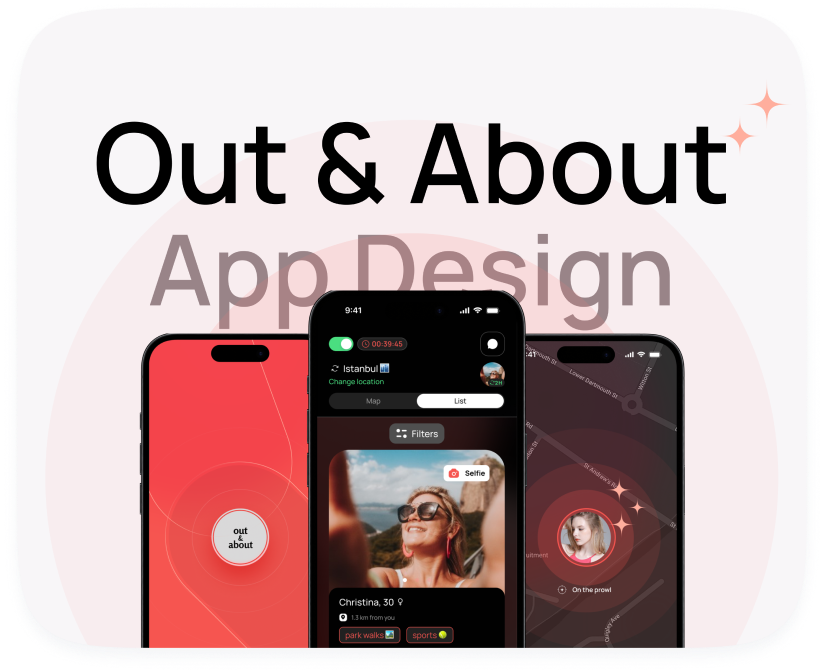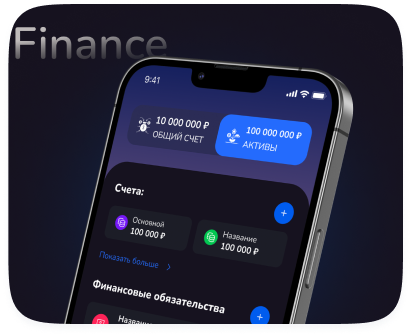
We build mobile apps





We work directly with every client
We deliver solutions with guaranteed results.

We build mobile apps






















It’s similar to buying a car at a dealership: you can go with the basic model, or choose a fully loaded version — it all depends on your needs and goals.

How to create YOUR OWN ChatGPT?

How to PROPERLY create a mobile app in 2024 | Step by step

You pay > We work > You receive the results. If you’re satisfied, you pay the next installment.
We need to have a call and discuss your specific requirements.
One thing we can say for sure: projects under 500,000 rubles are not feasible — we can’t deliver the required quality for less.
We launch, gather user feedback, and add new features that help you earn more from the app.
During development, I always design the architecture to make future updates and improvements easy and convenient.
Some apps perform better with influencer marketing, others through ad networks, and sometimes it’s even effective to buy a contact list and set up retargeting 😊
It all depends on your project’s specifics and is discussed personally.
How we can help:
- Set up ASO (App Store Optimization) and create an attractive app store page to drive free, organic installs.
- Help you develop the right promotion strategy tailored to your app.
- Share contacts of advertising experts I personally work with.
Спросить ChatGPT
The only ongoing cost is paying for the server (hosting).
You pay a subscription fee for the server. The more users your app has, the more server resources it consumes, and the higher the hosting costs.
At the early stages, when you have few users, the server will be FREE.
After that, the cost will gradually increase, but it remains affordable.
For example, an app with 100,000 users spent about $150 per month on hosting.
SaaS Application Development Services
Build Your SaaS Product
Introduction
Software as a Service (SaaS) has revolutionized the way businesses access and utilize software solutions. Instead of traditional on-premise installations, SaaS applications are hosted in the cloud and accessed via the internet, offering scalability, cost-effectiveness, and ease of maintenance. This article delves into the realm of SaaS application development services, exploring the process, benefits, and crucial considerations for building a successful SaaS product.
The demand for SaaS development is booming as companies of all sizes seek to leverage the advantages of cloud-based solutions. Finding the right SaaS application development services provider is crucial to realizing the full potential of your SaaS vision. This guide will provide you with the necessary insights to navigate the complexities of software as a service development.
What are SaaS Application Development Services?
SaaS application development services encompass the complete lifecycle of creating and deploying a software application hosted in the cloud and delivered to users over the internet. These services typically involve:
- Concept Validation and Business Analysis: Evaluating the market opportunity, defining the target audience, and outlining the core features and functionality of the SaaS application.
- UI/UX Design: Creating an intuitive and engaging user interface that enhances the user experience and drives adoption.
- Architecture Design: Designing a scalable, secure, and reliable cloud infrastructure to support the SaaS application.
- Development and Coding: Building the application using appropriate programming languages, frameworks, and databases.
- Testing and Quality Assurance: Thoroughly testing the application to ensure it meets performance, security, and usability standards.
- Deployment and Hosting: Deploying the application to a cloud platform (e.g., AWS, Azure, Google Cloud) and managing the hosting infrastructure.
- Maintenance and Support: Providing ongoing maintenance, updates, and technical support to ensure the application remains stable and secure.
Effective SaaS application development services not only involve technical expertise but also a deep understanding of business requirements and user needs. They focus on delivering a solution that solves a specific problem and provides value to the target audience.
Benefits of SaaS Application Development
Choosing a SaaS model offers numerous advantages over traditional software development. Here are some key benefits:
- Cost-Effectiveness: SaaS applications typically require lower upfront investment compared to on-premise software. Users pay a subscription fee, eliminating the need for expensive hardware, software licenses, and IT infrastructure.
- Scalability: SaaS applications can easily scale to accommodate growing user bases and increasing data volumes. Cloud infrastructure provides the flexibility to adjust resources as needed.
- Accessibility: SaaS applications can be accessed from any device with an internet connection, enabling users to work from anywhere at any time.
- Automatic Updates: SaaS providers handle all software updates and maintenance, freeing users from the burden of managing updates themselves.
- Faster Time to Market: SaaS development can be faster than traditional software development due to the availability of pre-built components and cloud-based infrastructure.
- Integration: SaaS applications can often be easily integrated with other cloud-based services, creating a seamless workflow.
Key Considerations for SaaS Application Development
Developing a successful SaaS application requires careful planning and execution. Here are some key considerations:
1. Market Research and Validation
Before investing in development, it's crucial to conduct thorough market research to validate the demand for your SaaS application. Identify your target audience, analyze your competitors, and define your unique value proposition.
2. Scalable Architecture
Design your application architecture with scalability in mind. Choose a cloud platform that can handle increasing traffic and data volumes. Implement techniques such as load balancing, caching, and database optimization to ensure optimal performance.
3. Security
Security is paramount for SaaS applications. Implement robust security measures to protect user data and prevent unauthorized access. This includes encryption, access control, vulnerability scanning, and regular security audits. Compliance with relevant regulations (e.g., GDPR, HIPAA) is also essential.
4. Multi-Tenancy
Multi-tenancy is a core principle of SaaS architecture. Design your application to efficiently serve multiple customers from a single instance. This requires careful consideration of data isolation, resource allocation, and customization options.
5. Subscription Model
Choose a subscription model that aligns with your target audience and business goals. Common options include tiered pricing, usage-based pricing, and freemium models. Consider offering different plans with varying features and storage limits.
6. User Experience (UX)
A positive user experience is crucial for SaaS adoption and retention. Invest in UI/UX design to create an intuitive and engaging application that is easy to use. Conduct user testing to gather feedback and iterate on the design.
7. API Integrations
Provide APIs to allow your SaaS application to integrate with other services and platforms. This can enhance its functionality and make it more valuable to users.
8. Monitoring and Analytics
Implement robust monitoring and analytics tools to track application performance, identify issues, and gather user insights. This data can be used to improve the application and optimize the user experience.
9. Choosing the Right Technology Stack
The technology stack you choose will significantly impact the performance, scalability, and maintainability of your SaaS application. Consider factors such as development cost, security, community support, and ease of integration when making your selection. Common technology choices include:
- Programming Languages: Python, JavaScript, Java, Ruby, PHP
- Frameworks: React, Angular, Vue.js, Node.js, Django, Ruby on Rails
- Databases: PostgreSQL, MySQL, MongoDB, Cassandra
- Cloud Platforms: AWS, Azure, Google Cloud Platform
10. Data Migration Strategy
If you're migrating existing data to your new SaaS application, having a clear and robust data migration strategy is vital. Consider data mapping, cleansing, transformation, and validation procedures. Minimize downtime during migration and ensure data integrity.
11. Legal and Compliance Considerations
Ensure your SaaS application complies with all relevant legal and regulatory requirements, including data privacy laws (GDPR, CCPA), industry-specific regulations (HIPAA, PCI DSS), and service level agreements (SLAs).
Selecting a SaaS Application Development Services Provider
Choosing the right SaaS application development services provider is crucial for the success of your project. Consider the following factors:
- Experience: Look for a provider with a proven track record of developing successful SaaS applications.
- Expertise: Ensure the provider has the necessary technical expertise in areas such as cloud computing, software architecture, and UI/UX design.
- Communication: Choose a provider with excellent communication skills and a collaborative approach.
- Project Management: Look for a provider with strong project management skills and a clear development process.
- Pricing: Compare pricing models and ensure transparency in costs.
- Client Testimonials: Review client testimonials and case studies to assess the provider's reputation and capabilities.
SaaS Application Development Cost
The cost of developing a SaaS application varies widely depending on several factors, including the complexity of the application, the features required, the technology stack used, and the location of the development team. Generally, costs can range from tens of thousands to hundreds of thousands of dollars.
Factors influencing cost include:
- Application Complexity: Simple applications with basic features will cost less than complex applications with advanced functionality.
- Number of Features: The more features you require, the higher the development cost will be.
- Technology Stack: The choice of technology stack can impact development costs. Some technologies are more expensive to implement and maintain than others.
- Development Team Location: Development costs vary significantly depending on the location of the development team. Outsourcing to countries with lower labor costs can reduce overall costs.
- UI/UX Design: A well-designed and user-friendly interface requires more investment in UI/UX design.
SaaS Examples
SaaS solutions are widely used across various industries. Examples include:
- Customer Relationship Management (CRM): Salesforce, HubSpot
- Project Management: Asana, Trello
- Collaboration Tools: Slack, Microsoft Teams
- E-commerce Platforms: Shopify, BigCommerce
- Accounting Software: Xero, QuickBooks Online
Table: Comparison of SaaS Development Approaches
| Approach | Pros | Cons | Suitable for |
|---|---|---|---|
| In-House Development | Full control over the development process, deep understanding of the business requirements. | Higher costs, requires a dedicated team, slower time to market. | Large enterprises with complex requirements and ample resources. |
| Outsourcing | Lower costs, access to specialized expertise, faster time to market. | Potential communication challenges, less control over the development process, risks of intellectual property theft. | Startups and small businesses with limited resources. |
| Hybrid Approach | Combines the benefits of both in-house and outsourcing. | Requires careful coordination and management. | Medium-sized businesses with specific expertise gaps. |
Conclusion
SaaS application development services offer a powerful way to build and deploy software solutions that are scalable, cost-effective, and accessible. By carefully considering the key factors outlined in this article and choosing the right development partner, you can increase your chances of creating a successful SaaS product that meets the needs of your target audience and drives business growth. The right SaaS development partner will understand your business goals and provide the expertise necessary to bring your vision to life in the cloud. Remember to focus on a user-centric design, robust security, and a scalable architecture to ensure long-term success in the competitive software as a service landscape.






